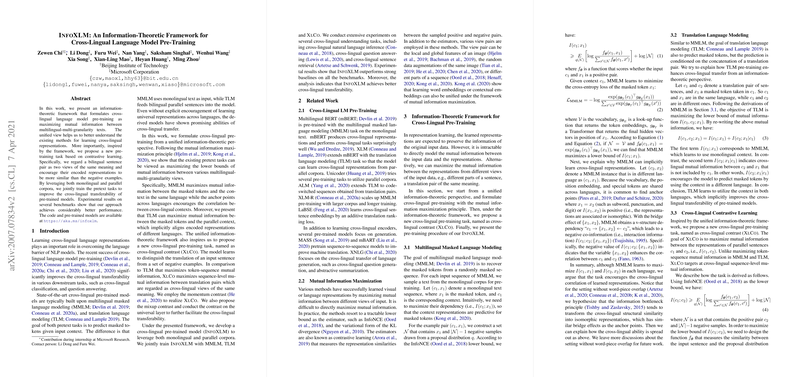An Overview of "InfoXLM: An Information-Theoretic Framework for Cross-Lingual LLM Pre-Training"
The paper, "InfoXLM: An Information-Theoretic Framework for Cross-Lingual LLM Pre-Training," presents a novel approach to pre-training cross-lingual LLMs by leveraging information-theoretic principles. The proposed framework, InfoXLM, aims to enhance the cross-lingual transferability of pre-trained models by maximizing mutual information between multilingual-multi-granularity views. This is achieved through a combination of novel pre-training tasks and existing methods.
Core Concept: Mutual Information Maximization
The paper formulates cross-lingual pre-training as an exercise in mutual information maximization. The key insight is that traditional tasks like multilingual masked LLMing (MMLM) and translation LLMing (TLM) can be re-interpreted through the lens of mutual information. MMLM aims to maximize mutual information between context and masked tokens, implicitly benefiting cross-lingual tasks through shared vocabularies or token alignment across languages. TLM further extends this by considering bilingual sentence pairs, thereby aligning cross-lingual representations more explicitly.
Introduction of Cross-Lingual Contrast
One of the significant contributions of this paper is the introduction of a new pre-training task, named cross-lingual contrastive learning (XlCo). This task is designed to maximize mutual information at the sequence level between translation pairs, rather than at the token level. The task employs contrastive learning principles, distinguishing translated sentences from negative examples drawn from a queue, following the momentum contrast method.
Model Architecture and Training
The InfoXLM model harnesses both monolingual and parallel corpora and combines MMLM, TLM, and the newly introduced XlCo for training. It builds upon the Transformer architecture and has been tested in both base and large model configurations. The joint optimization of these tasks leads to improved cross-lingual representations, enabling more robust performance on downstream tasks.
Experimental Evaluation
The model's effectiveness is demonstrated on several cross-lingual understanding tasks, including natural language inference (XNLI), question answering (MLQA), and sentence retrieval (Tatoeba). The experiments reveal that InfoXLM outperforms existing models, both in zero-shot and translate-train-all settings, signifying the model’s strengthened cross-lingual transferability. The paper reports substantial improvements in alignment of cross-lingual sentence representations, reflected in enhanced retrieval accuracy.
Implications and Future Directions
The integration of an information-theoretic perspective into cross-lingual LLM pre-training opens new avenues for enhancing multilingual language processing capabilities. The unified approach underscores the critical role of mutual information in cross-lingual tasks and paves the way for future research into more granular or alternative views that can be leveraged for contrastive learning. Extensions of this framework might include additional linguistic structures or more diverse negative sampling techniques, potentially improving cross-lingual alignment further.
Conclusion
"InfoXLM: An Information-Theoretic Framework for Cross-Lingual LLM Pre-Training" marks a significant contribution to the cross-lingual NLP landscape. By casting pre-training tasks within an information-theoretic context, it provides a robust foundation for learning universal representations that transcend linguistic boundaries. It is anticipated that this framework will prompt subsequent explorations into optimizing multi-view learning in LLMs and inspire future research in cross-lingual NLP and beyond.
